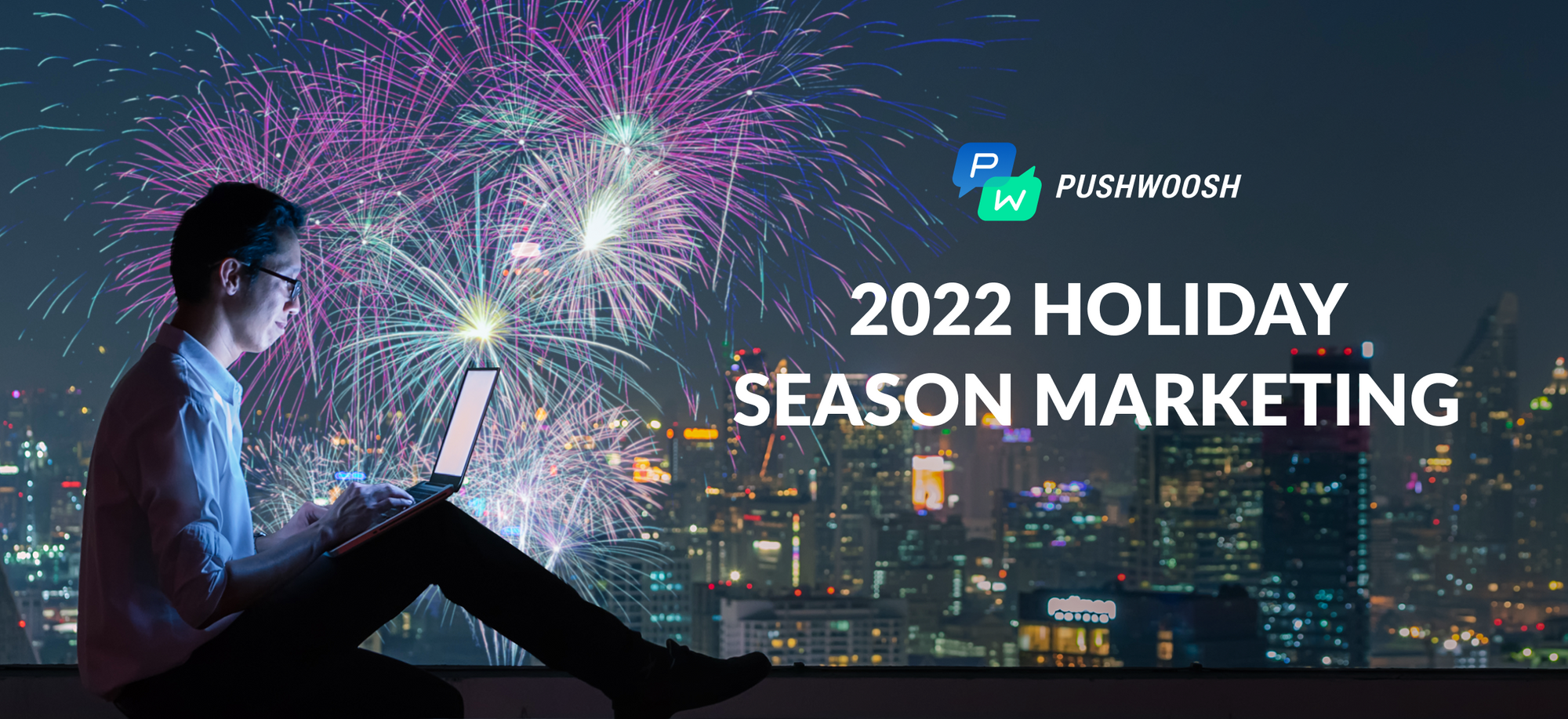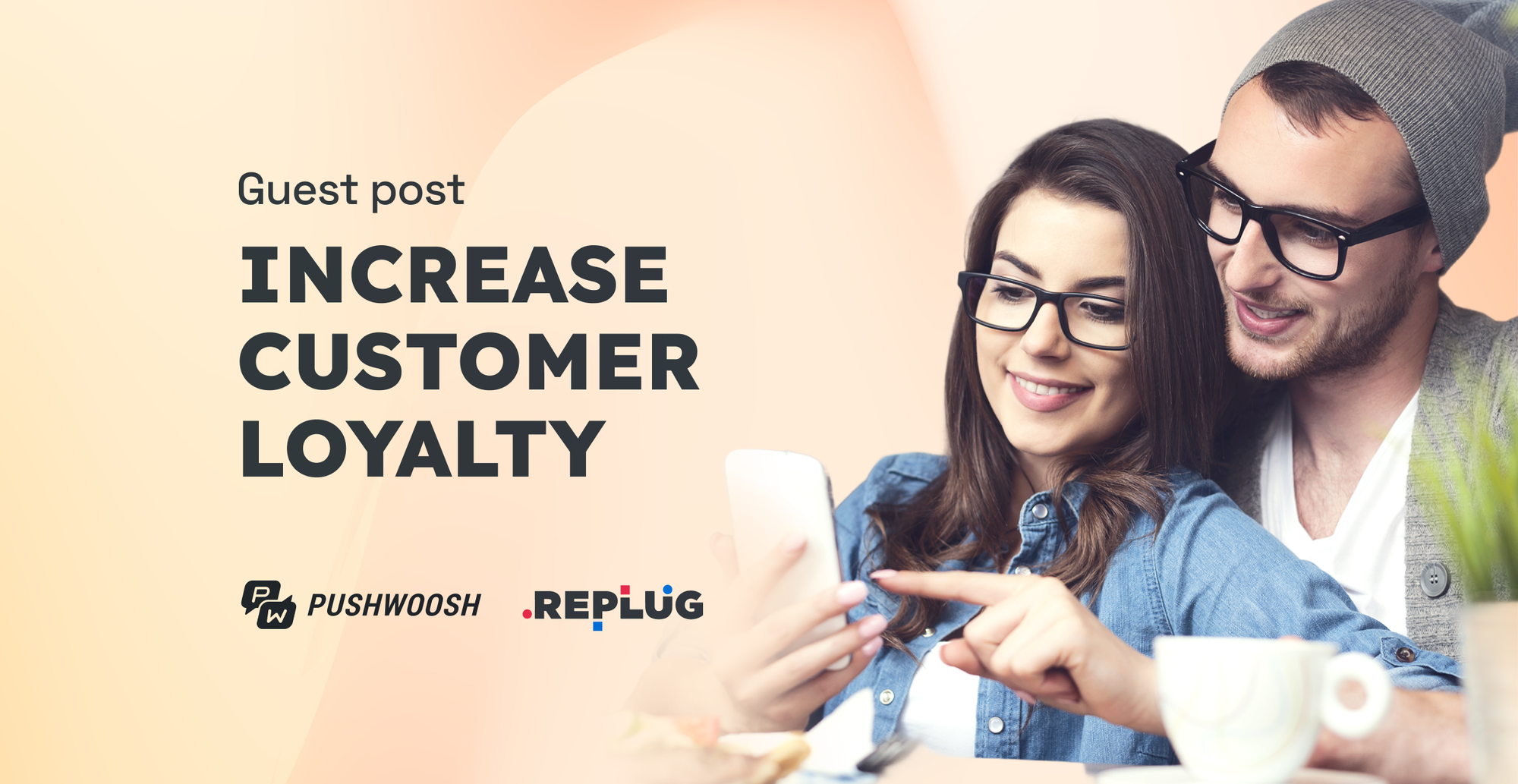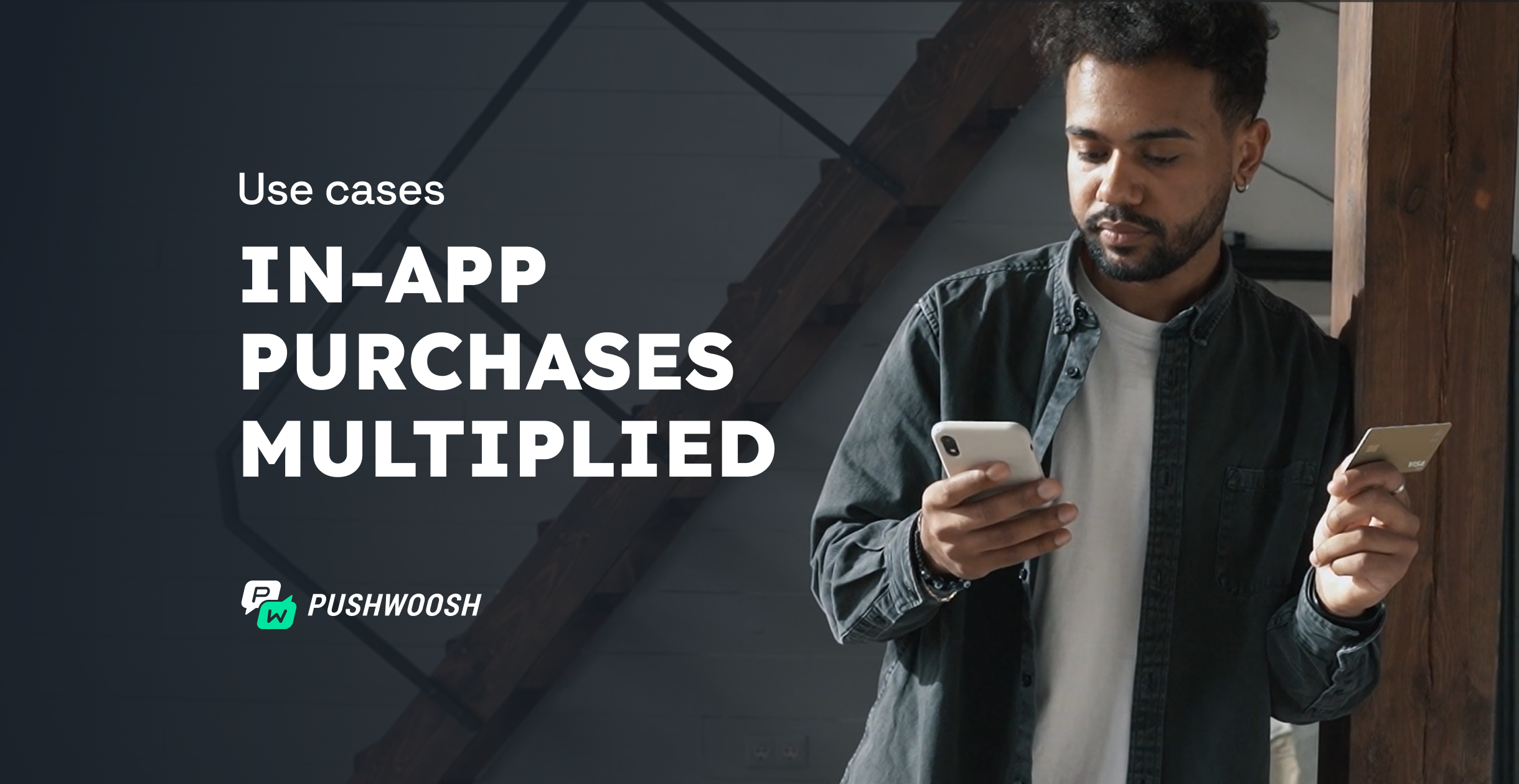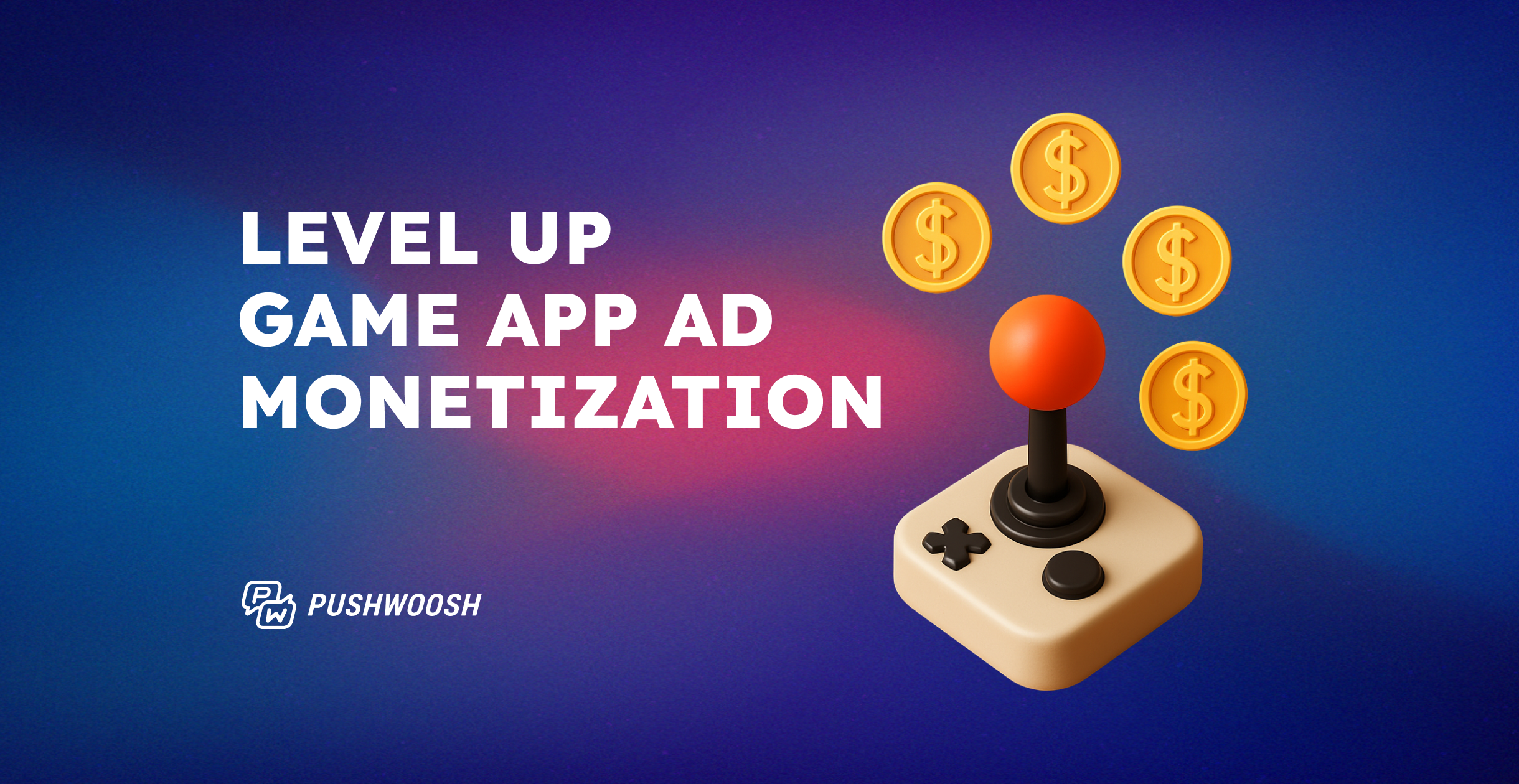7 Steps to a Winning Mobile App Marketing Strategy for the 2022 Holiday Season
The holiday season is undoubtedly the busiest time in e-commerce. During these several weeks, online sales peak; in 2021, they broke even the previous year’s record with another 11% YoY growth.
The challenging part is that many e-tailers start their holiday season promo as early as mid-October, and by the dates when actual holidays approach, their creative marketing resources may be getting scarce. Is it your case, and you’re looking for more ideas to maximize your conversions and sales? Or haven’t you had a chance to adjust your regular activities to the holiday season yet?
Either way, you’ll find some useful tips in this mobile app marketing guide based on Pushwoosh’s years of experience working with e-commerce customers and the most recent industry analytics.
When Is the Best Time to Start Your Holiday Mobile App Marketing Campaign?
Choose a Strategic Focus of Your Holiday Season Marketing Campaign
Ensure Your Customers Have the Latest Version of Your E-Commerce App
Create Personalized Messages for Each Customer Segment — and Even Each Customer Individually
Share the Holiday Spirit with All Your E-Commerce App Users: Update Your Icon
More Ideas for Your Holiday Season Mobile App Marketing Strategy
When Is the Best Time to Start Your Holiday Mobile App Marketing Campaign?
Ideally, you want to be there by the time the majority of high-value customers begin their holiday shopping. When is it, exactly?
According to Deloitte, this year, you’ll find 68% of customers searching for gifts and deals before Thanksgiving. These early shoppers will make the most profitable target audience for you as they will spend 23% more than those who will make their purchases later.
If you can launch a pre-holidays campaign in the upcoming days, you may grasp the maximum attention and secure your place in the most active buyers’ shopping lists.
Source: 2021 Deloitte holiday retail survey
If you can only pull off a special holiday campaign after Thanksgiving, make the best use of the next dates: Cyber Monday (that is, in fact, a customers’ favorite shopping event), Green Monday, Free Shipping Day, and each of the end-of-year holidays specifically.
Source: 2021 Deloitte holiday retail survey
Be reassured: you may get sufficient revenue on these dates as they are mostly popular among high-income (and high-spending!) individuals.
- Choose a Strategic Focus of Your Holiday Season Marketing Campaign
Before you dive into writing down any specific steps, decide on your general strategy: will it be more profitable to focus on customer acquisition or, rather, customer engagement and re-engagement? Especially considering the tight deadlines you have for your holiday season campaign launch.
If you choose to focus on acquiring new customers, beware of the pitfalls:
🚩 Acquisition costs, which are high throughout the entire year, are especially high during the holiday season;
🚩 You’ll be pressured to attract, engage, and convert a new audience in a limited timeframe;
🚩 Customer data privacy limitations imposed by mobile operating systems make acquisition less effective. So those extra advertising expenses won’t necessarily pay off in high conversions.
On the other hand, choosing to engage your existing customer base may be a smart strategic move — as Baymard Institute reports:
🟢 Repeat customers are 9 times more likely to convert;
🟢 Retained clients spend an extra 25% on holiday shopping.
From our experience, we would recommend you bet on the engagement strategy as it can give the greatest boost to your e-commerce sales and result in the highest ROI.
👍Mobile marketing experts argue that an effective strategy never puts user acquisition above retention. Read what the leaders recommend.
- Peek on Your Competitors to Make Informed Decisions
It may turn out, your competitors are already testing some of your holiday marketing ideas. If so, you may even check how they perform: use competitive intelligence tools to detect any changes in your rivals’ SEO tactics, ads settings, traffic acquisition channels, and messages. Have any of these holiday tweaks paid off yet, according to competitor analysis tools?
This step will help you uncover more promising opportunities and shelve the unprofitable ones.
- Ensure Your Customers Have the Latest Version of Your E-Commerce App
Imagine a customer that has picked a long list of products and is already there looking at the checkout screen. There, an error occurs, and all the items disappear from the cart. The purchase has not been completed. A customer will have a horrible time then, picking the same items for the second time and, probably, abandoning some of them. Or even worse, they may leave your app because they can’t stand the shopping experience like that.
You know such a bug happened in a previous version of your app, but your team has already fixed it! Why doesn’t a customer have this latest version installed on their device?
Well, luckily, you can get proactive and protect your business from such an unfortunate (and perfectly common) risk.
Initiate the update of your app on users’ devices by sending them a Silent Push with Custom Data in it. This kind of notification quietly delivers the needed data to your users’ application and activates whatever is put in there in the background. A Silent Push doesn’t require your users’ attention, makes no alert and no sound, and helps you:
- Track the number of app uninstalls;
- Clean up your user base. Each time a Silent Push is sent, all invalid or non-existent push tokens will be removed from our database;
- Enable a holiday sales section in your app;
- Release a new holiday-inspired design theme;
- Update your app icon and logo design to drive more attention to your mobile commerce.
- Segment Your Customers Like Your Conversion Depends on It
Spoiler: actually, it does.
According to Pushwoosh’s recent internal research, when an app applies behavioral segmentation to its marketing communications, its conversion-to-purchase rates grow by hundred times, compared to broadcast campaigns with similar messages and CTAs. The numbers are astonishing, but this is what Pushwoosh customers really achieve by taking segmentation seriously.
Here are just several ideas of which segments you may want to specify for your e-commerce app:
Ideally, we recommend you pull out all the available data from your online and offline customer data sources. This way, you’ll even get to distinguish the regulars of your offline store (if you have one) who have just installed your mobile app from those customers who are completely new to your e-commerce brand. Isn’t it amazing?
Here is how you can do it in Pushwoosh Customer Journey Builder: out of all the users who have triggered the “App Install” event, you want to segment out those who you have listed as “Purchased Offline” and split your further communication flow accordingly.
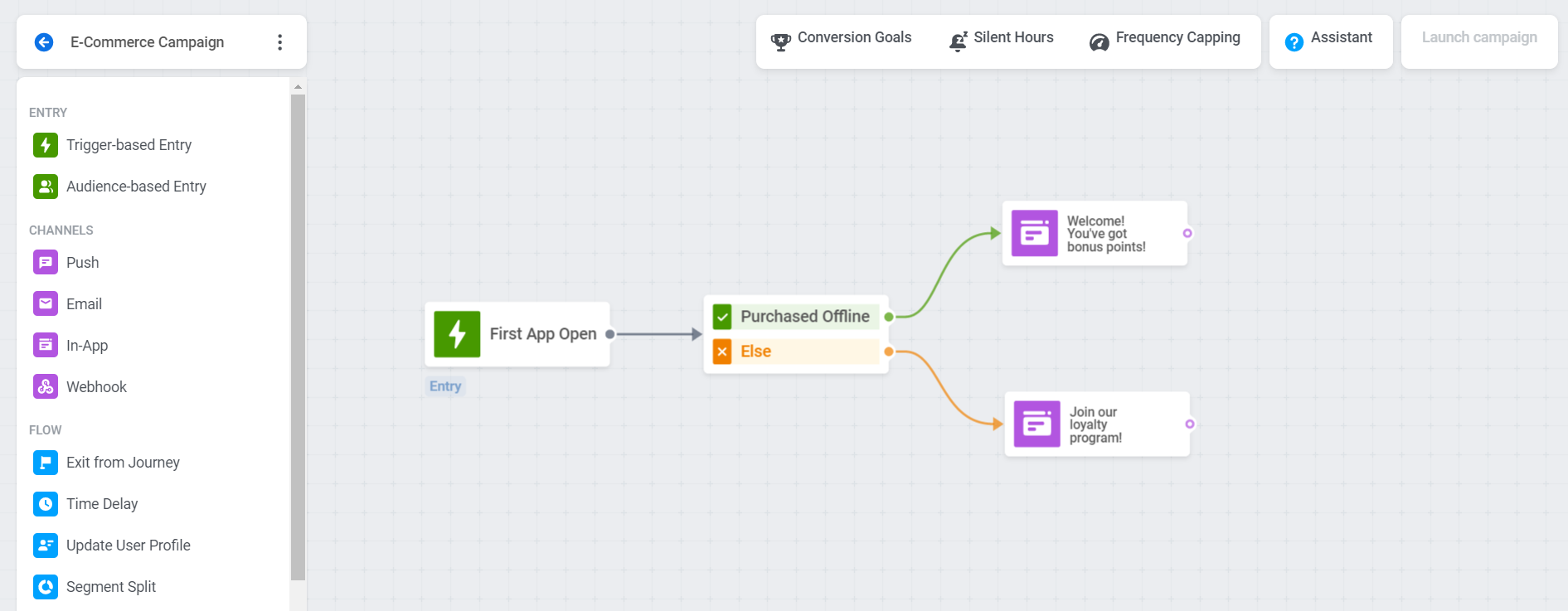
A screenshot from Pushwoosh Customer Journey Builder
When you’re short on time, you may segment your e-commerce app audience quickly within Pushwoosh, using behavioral data and attributes you have collected inside your app.
A simple example: during the holiday season, brands focus on major end-of-year holidays, overlooking a more personal reason why customers may do shopping — their birthdays. You may target the customers who have indicated their birthday date in December and send them an email with some ideas for their wishlist. This way, you can gain extra points (and revenue) for your e-commerce brand.
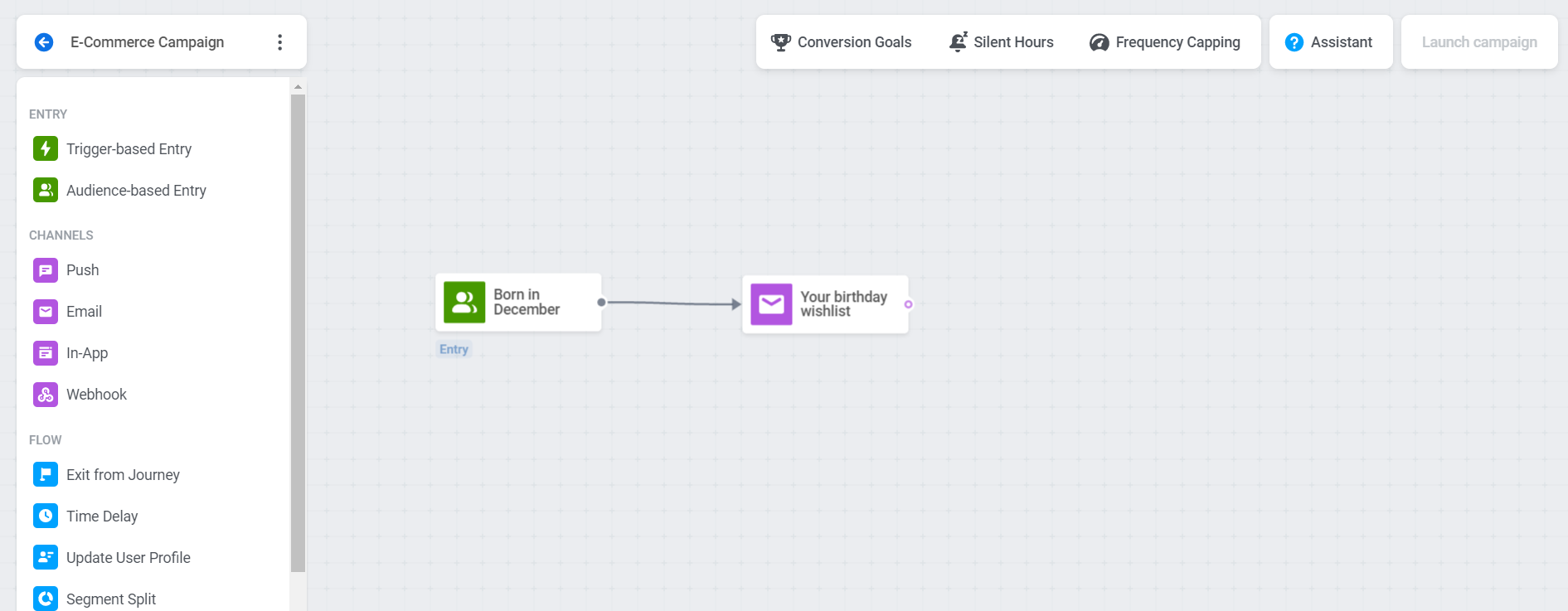
Created in Pushwoosh Customer Journey Builder
Explore Pushwoosh Customer Journey Builder
- Create Personalized Messages for Each Customer Segment — and Even Each Customer Individually
Yes, it is an advanced step but not as complicated as it may seem. You’ve already done half of the job by creating customer segments. Now you want to target those groups with relevant offers.
For example, the customers who have put something in their favorites should receive in-app messages or push notifications with a reference to those items. And the shoppers who haven’t selected any favorite products should receive in-apps and pushes featuring the items that you recommend to them.
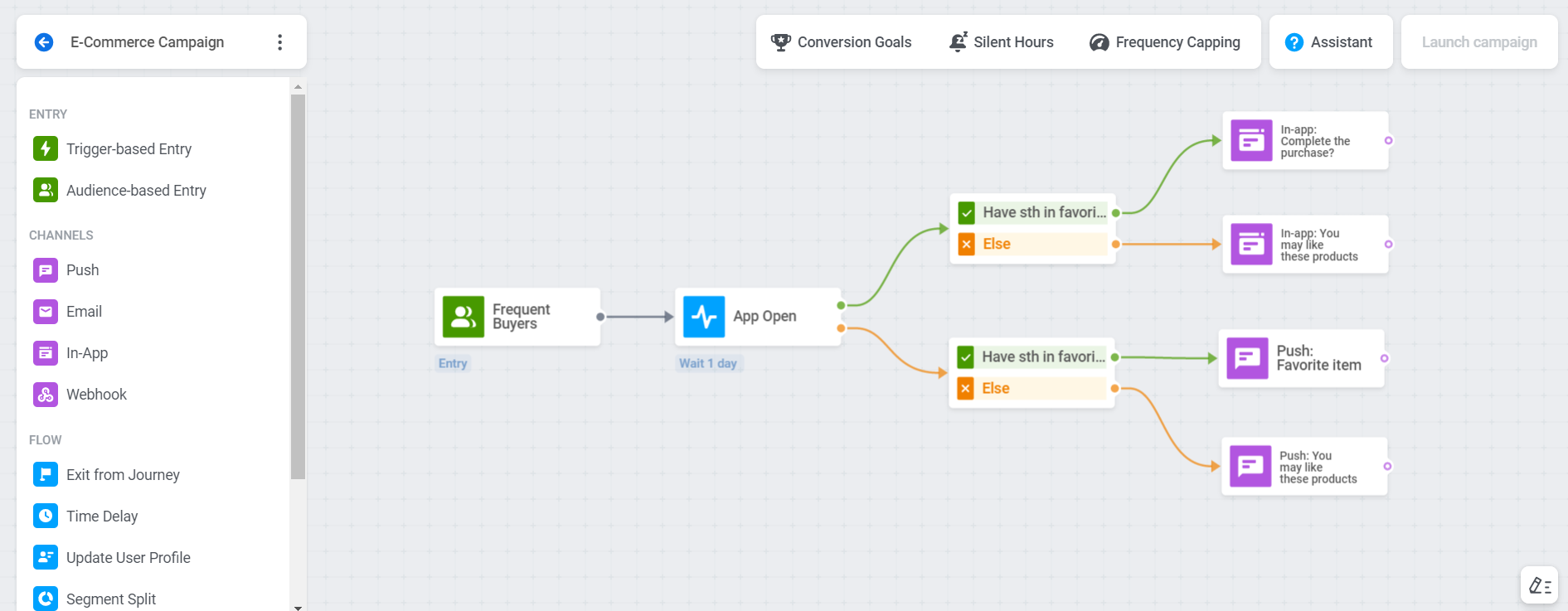
Made with Pushwoosh Customer Journey Builder
Learn more about personalized e-commerce messaging
- Synchronize Your Messaging Across the Channels
You don’t want to make the awkward mistake of announcing “an extra discount for loyalty program members only” on one channel and “sales for everyone” on the other. Marketing automation can save you from this risk; it can also increase the chances of your customers hearing your message and acting upon it.
What should you do?
Just entrust your mobile app campaigns to an omnichannel communications solution like Pushwoosh Customer Journey Builder. You can use its single-channel alternatives that enable push notification, in-app message, and email sending separately, but in this case, you’ll have to be very attentive about your campaign orchestration.
Since we’re talking about the quickest ways to launch a holiday season mobile app marketing campaign, we encourage you to get all your channels connected in one tool.
- Share the Holiday Spirit with All Your E-Commerce App Users: Update Your Icon
Whatever course you take in your holiday season campaign, both your current customers and just-installed users will pay attention to your app icon. How about tweaking its look for the next shopping event or festive date?
Such a quick redesign will inevitably draw attention to your app and can both re-engage your regular users and boost the number of new installs. You can even make it part of your holiday app gamification — for example, you can split your users’ path inside the app into several milestones. Once the user reaches one, update the app icon.
More Ideas for Your Holiday Season Mobile App Marketing Strategy
These are just a few tips we encourage you to try during this busiest shopping season. Hopefully, you will see more customers open your marketing messages, consider your offers and ultimately convert. This extra-crowded holiday season may be the perfect time for you to gather some robust data on your customer behavior. You can analyze it when the holidays end and then use the findings in your ongoing campaigns.
Learn how Pushwoosh can get your e-commerce business covered at all stages, from the strategic choice of channels to audience segmentation, content creation, and marketing analytics.
Discover Pushwoosh for E-Commerce
Gain more insights for your 2022 messaging campaigns from our newest data study of e-commerce apps:
